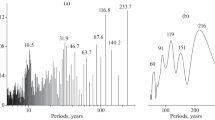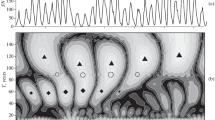Abstract
The wavelet analysis was used to study the spectral composition of the sunspot numbers SN during 1700–2021. In addition to the dominant 11-year component, two powerful components of the Gleissberg cycle can be traced in the spectrum: before 1880, a branch with a period of ~60 years; from 1850 a branch of ~115 years is found. It is found that the series of lengths and amplitudes of the solar cycle as a whole are inversely related (correlation coefficient k = –0.5–0.63). The interval between the series at which the maximum anticorrelation is reached depends on time. In the 18th and early 19th centuries, the lag was equal to one cycle, in the 19th century it was two cycles, and from 1950 to our time the lag decreased to 2 years. Quasi-periodic structures, which are typical for long periods of low solar activity, have been identified. Such a spectral feature in ~1800 (Dalton minimum) was caused by the influence of the 60-year branch, while the one that has been forming since the beginning of the 21st century is due to the weaker influence of the circa-centenary branch. Therefore, it should be expected that the next solar cycles will be higher and shorter than during the period of the Dalton minimum. It has been shown that solar cycle length variations for the last 321 years can be described within the framework of the model, which is an 11-year oscillation that is subject to frequency modulation by the branches of the Gleisberg cycle (60 and 115 years) with time-varying influences of the modulator.







Similar content being viewed by others
REFERENCES
Abreu, J.A., Beer, J., Ferriz-Mas, A., McCracken, K.G., and Steinhilber, F., Is there a planetary influence on solar activity?, Astron. Astrophys., 2012, vol. 548, no. A88. https://doi.org/10.1051/0004-6361/201219997
Bertolucci, S., Zioutas, K., Hofmann, S., and Maroudas, M., The Sun and its planets as detectors for invisible matter, Phys. Dark Universe, 2017, vol. 17, pp. 13–21. https://doi.org/10.1016/j.dark.2017.06.001
Clette, F. and Lefèvre, L., The new sunspot number: Assembling all corrections, Sol. Phys., 2016, vol. 291, pp. 2629–2651. https://doi.org/10.1007/s11207-016-1014-y
Clilverd, M.A., Clarke, E., Ulich, T., Rishbeth, H., and Martin, J., Predicting solar cycle 24 and beyond, Space Weather, 2006, vol. 4, no. 9, S09005. https://doi.org/10.1029/2005SW00027
Daubechies, I., Ten Lectures on Wavelets, Philadelphia, Pa.: Society for Industrial and Applied Mathematics, 1992. https://doi.org/10.1137/1.9781611970104.
Gleissberg, W., Evidence for a long solar cycle, The Observatory, 1944, vol. 65, no. 282, pp. 123–125.
Gleissberg, W., The eighty-year solar cycle in auroral frequency numbers, J. Br. Astron. Assoc., 1965, vol. 75, pp. 227–231.
Gonorovskii, I.S., Chastotnaya modulyatsiya i ee primeneniya (Frequency Modulation and Its Applications), Moscow: Svyaz’izdat, 1948.
Grossman, A. and Morlet, J., Decomposition of Hardy functions of constant shape, SIAM J. Math., 1984, vol. 15, no. 4, pp. 723–736. https://doi.org/10.1137/0515056.m
Hathaway, D.H., The solar cycle, Living Rev. Sol. Phys., 2015, vol. 12, id 4. http://www.livingreviews.org/lrsp-2015-4. https://arxiv.org/pdf/1502.07020.
Ishkov, V.N. and Shibaev, I.G., Solar activity cycles: General characteristics and modern forecasting boundaries, Bull. Russ. Acad. Sci., Phys., 2006, vol. 70, no. 10, pp. 1643–1647.
Komitov, B., Sello, S., Duchlev, P., Dechev, M., Penev, K., and Koleva, K., The sub- and quasi-centurial in solar and geomagnetic activity data series, Bulg. Astron. J., 2016, vol. 25, pp. 78–103.
McCracken, K.G., Beer, J., Steinhilber, F., and Abreu, J., A phenomenological study of the cosmic ray variations over the past 9400 years, and their implications regarding solar activity and the solar dynamo, Sol. Phys., 2013, vol. 286, no. 2, pp. 609–627.
Nagovitsyn, Yu.A., Solar activity during the last two millennia: “Solar Patrol” in ancient and medieval China, Geomagn. Aeron. (Engl. Transl.), 2001, vol. 41, no. 5, pp. 680–688.
Nagovitsyn, Yu.A. and Pevtsov, A.A., Nonlinear mathematical model of spot solar cyclicity, in Tr. XXII Vserossiiskoi konf. Solnechnaya i solnechno-zemnaya fizika-2018, Pulkovo, Stepanov, A.V. and Nagovitsyn, Yu.A., Eds., St. Petersburg: GAO RAN, 2018, pp. 307–310. https://doi.org/10.31725/0552-5829-2018-307-310.
Nagovitsyn, Yu.A. and Pevtsov, A.A., Duffing oscillator model of solar cycles, Astrophys. J. Lett., 2020, vol. 888, no. 2, L26. https://doi.org/10.3847/2041-8213/ab6335
Nandy, D., Progress in solar cycle predictions: Sunspot cycles 24–25 in perspective, Sol. Phys., 2021, vol. 296, no. 54. https://doi.org/orcid.org/0000-0003-0489-0920
Obridko, V.N. and Nagovitsyn, Yu.A., Solnechnaya aktivnost', tsiklichnost' i metody prognoza (Solar Activity, Cyclicity, and Prediction Methods), St. Petersburg, VVM, 2017.
Obridko, V.N., Katsova, M.M., and Sokoloff, D.D., Solar and stellar activity cycles – no synchronization with exoplanets, Mon. Not. R. Astron. Soc., 2022, vol. 516, no. 1, pp. 1251–1255. https://doi.org/10.1093/mnras/stac2286
Ogurtsov, M.G., Nagovitsyn, Yu.A., Kocharov, G.E., and Jungner, H., Long-period cycles of the Sun’s activity recorded in direct solar data and proxies, Sol. Phys., 2002, vol. 211, pp. 371–394. https://doi.org/10.1023/A:1022411209257
Owens, M.J., Lockwood, M., and Riley, P., Global solar wind variations over the last four centuries, Sci. Rep., 2017, 41548. https://doi.org/10.1038/srep41548
Ptitsyna, N.G. and Demina, I.M., Reconstruction of the solar activity in 1000–1700 based on auroral data with allowance for the contribution of the main magnetic field of the Earth, Geomagn. Aeron. (Engl. Transl.), 2020, vol. 60, no. 3, pp. 495–506. https://doi.org/10.1134/S0016793220030159
Ptitsyna, N.G. and Demina, I.M., Solar-activity cycles reconstructed from statistics on polar lights with allowance for the contribution of the main magnetic field of the Earth in 1000–2000, Geomagn. Aeron. (Engl. Transl.), 2021, vol. 61, no. 2, pp. 312–324. https://doi.org/10.1134/S0016793221020122
Ptitsyna, N.G. and Demina, I.M., Frequency modulation as a cause of additional branches of the Gleissberg cycle in solar activity, Geomagn. Aeron. (Engl. Transl.), 2022, vol. 62, no. 1, pp. S48–S61. https://doi.org/10.1134/S0016793222010169
Richards, M.T., Rogers, M.L., and Richards, D.St.P., Long-term variability in the length of the solar cycle, Publ. Astron. Soc. Pac., 2009, vol. 121, pp. 797–809.
Scafetta, N., Multi-scale harmonic model for solar and climate cyclical variation throughout the Holocene based on Jupiter–Saturn tidal frequencies plus the 11-year solar dynamo cycle, J. Atmos. Sol.-Terr. Phys., 2012, vol. 80, pp. 296–311. https://doi.org/10.1016/j.jastp.2012.02.016
Scargle, J.D., Wavelet and other multi-resolution methods for time series analysis, in Statistical Challenges in Modern Astronomy II, Babu, G.J. and Feigelson, E.D., Eds., New York: Springer, 1997, pp. 333–347.
Shibaev A. and Shibaev I., Influence of the length of the WSN series on the period of the “Gleisberg cycle”, Proc. 16th Int. Conference on Space, Ecology, Safety–SES 202, Sofia, Bulgaria, 4–6 November 2020, pp. 40–44. 2020.
Silverman, S.M., Secular variation of the aurora for the past 500 years, Rev. Geophys., 1992, vol. 30, no. 4, pp. 333–351.
Solanki, S.K., Krivova, N.A., Schüssler, M., and Fligge, M., Search for a relationship between solar cycle amplitude and length, Astron Astrophys., 2002, vol. 396, pp. 1029–1035. https://doi.org/10.1051/0004-6361:20021436
Sonett, C.P., Sunspot index infers a small relict magnetic field in the Sun’s core, Nature, 1983, vol. 306, pp. 670–673.
Svalgaard, L., Up to nine millennia of multimessenger solar activity, 2018. https://arxiv.org/ftp/arxiv/papers/1810/ 1810.11952.pdf.
Usoskin, I.G., A history of solar activity over millennia, Living Rev. Sol. Phys., 2017, vol. 14, p. 3. https://doi.org/10.1007/s41116-017-0006-9
Usoskin, I.G. and Mursula, K., Long-term solar cycle evolution: Review of recent developments, Sol. Phys., 2003, vol. 218, pp. 319–343. https://doi.org/10.1023/B:SOLA.0000013049.27106.07
Vitinskii, Yu.I., Statistika pyatnoobrazovatel’noi deyatel’nosti Solntsa (Statistics of Sunspot Formation Activity), Moscow: Nauka-Fizmatlit, 1986.
Wilson, S.G., Digital Modulation and Coding, Charlottesville, Va.: Prentice-Hall, 1996.
Wolf, R., Extract of a letter to Mr. Carrington, Mon. Not. R. Astron. Soc., 1859, vol. 19, p. 85.
Zharkova, V., Shepherd, S., Popova, E., and Zharkov, S.I., Heartbeat of the Sun from principal component analysis and prediction of solar activity on a millenium timescale, Sci. Rep., 2015, vol. 5, 15689. https://doi.org/10.1038/srep15689
Zioutas, K.M., Tsagri, Y.K., Semertzidis, T., Papaevangelou, D., Hoffmann, H.H., and Anastassopoulos, V., The 11-years solar cycle as the manifestation of the dark universe, Mod. Phys. Lett. A, 2013, vol. 29, pp. 1–37. https://doi.org/10.1142/S0217732314400082
ACKNOWLEDGMENTS
The authors thank V.N. Ishkov and an anonymous referee for remarks and comments that helped to improve the article, and the WDC-SILSO team, Royal Observatory of Belgium, for the opportunity to use sunspot number series.
Author information
Authors and Affiliations
Corresponding author
Ethics declarations
The authors declare no conflicts of interest.
Rights and permissions
About this article
Cite this article
Ptitsyna, N.G., Demina, I.M. Influence of the Gleissberg Cycle on Variations of the 11-Year Cycle of Solar Activity in 1700–2021. Geomagn. Aeron. 63, 248–260 (2023). https://doi.org/10.1134/S0016793222600862
Received:
Revised:
Accepted:
Published:
Issue Date:
DOI: https://doi.org/10.1134/S0016793222600862




